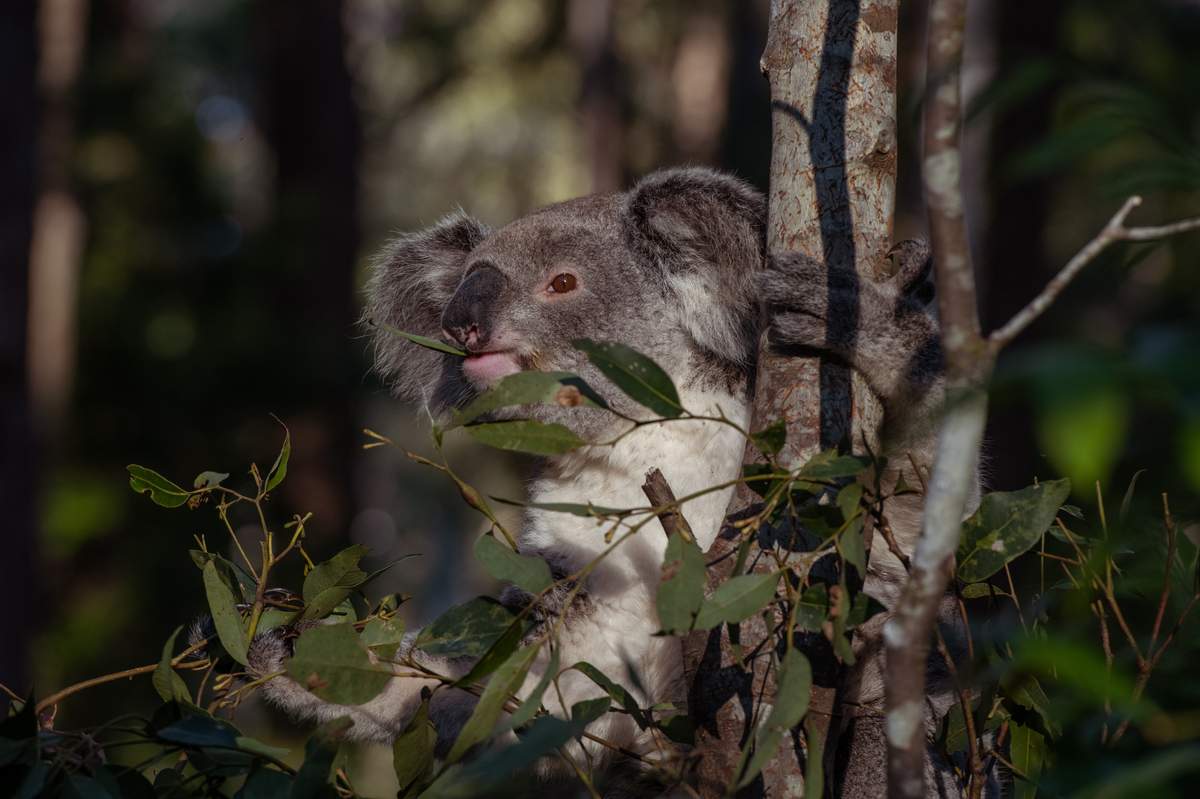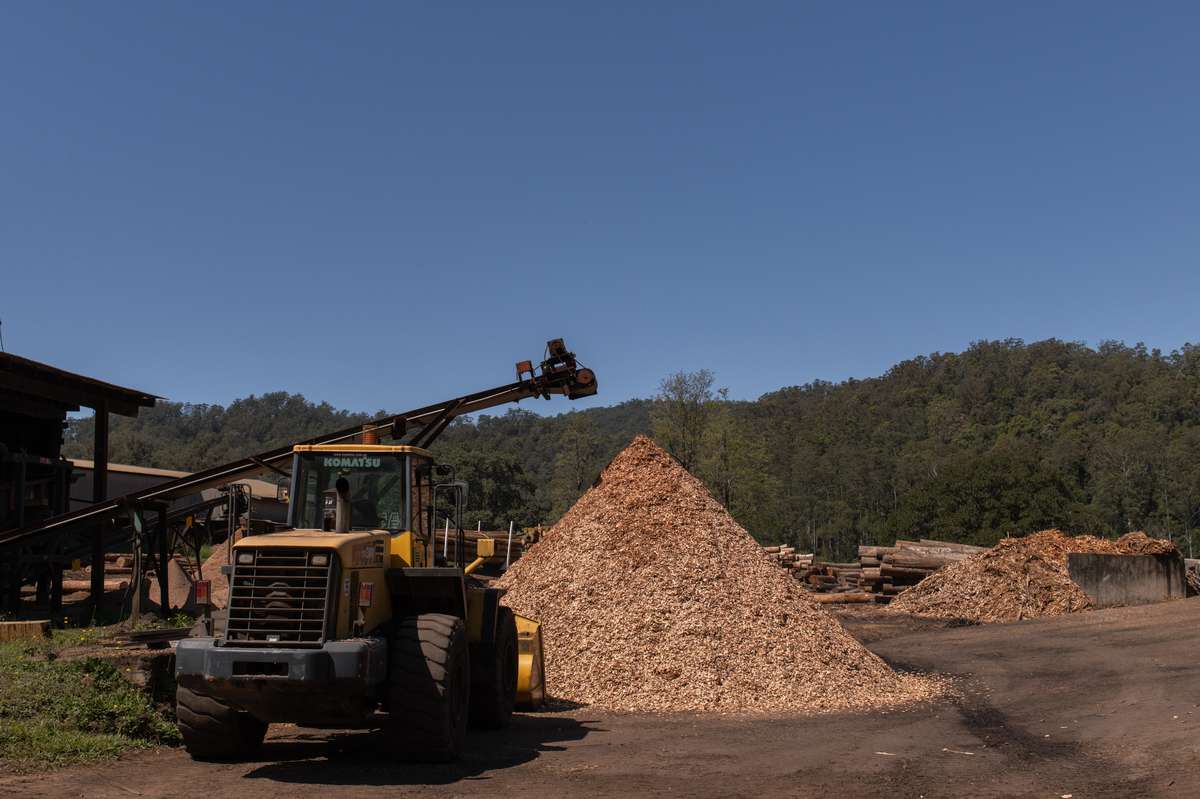
Lee, 5, during feeding time at the breeding program in Guulabaa.
15:37 JST, November 10, 2024
SHEAS NOB STATE FOREST, Australia – The ecologist drove his weathered pickup truck through thick and shady eucalyptus forest. But as he reached a ridgeline, the woodland suddenly gave way to a sunbaked clearing of barren dirt and splintered wood the size of a football field.
“This was all koala habitat,” said Mark Graham, shaking his head. He pulled over to examine a gray gum tree that had been cut down by loggers since he’d been here a few weeks earlier. What was left of its trunk showed scratches from koalas climbing it. Now the animals were gone.
“Welcome to the Great Koala National Park,” Graham said sarcastically.
The center-left Labor Party swept to power in New South Wales, the country’s most populous state, in March last year with an environmental election pledge: It would stitch together up to 1,200 square miles of state and national forests to create one uninterrupted koala sanctuary. It committed more than $110 million to protect the species, including $53 million over four years to support the development of the park.
The need was dire.
Thousands of koalas died in devastating bushfires five years ago, and many populations were already in decline after a steady drumbeat of logging, housing developments, dog attacks, car strikes and other threats. In 2022, the federal government declared koalas endangered.
The population in New South Wales was particularly imperiled: A parliamentary inquiry warned in 2020 that the marsupials would become extinct by 2050 without bold action.
Many of the state’s remaining animals live in areas now being assessed for the Great Koala National Park, a patchwork of eucalyptus forests stretching from the mountains to the coast that Graham calls “Australia’s Serengeti.”
The state government is consulting with environmentalists, industry leaders and local Aboriginal groups before it decides on the boundaries. A decision is expected in the next few months.
“We are committed to creating the Great Koala National Park,” New South Wales Environment Minister Penny Sharpe said in an interview. “It’s a really important part of our plan to save koalas in the wild. I just ask people to be patient for a little bit longer. We’re going to do it right and we’re going to do it well.”
But patience is wearing thin among wildlife advocates and environmentalists, who are angry with what they see as slow progress on an urgent issue.
“It’s been more than 18 months since the government was elected,” Graham said. “With each day that goes by, it becomes more and more of a broken promise.”
Environmentalists are particularly incensed that logging continues in the area designated to become a refuge while the state government considers how to draw the park.
Although logging has been suspended in roughly 32 square miles identified as “koala hubs” – the most critical koala habitat – that means 95 percent of the state forests under consideration are still open to logging.
Activists are concerned that the lengthy process has given the state-owned logging company, Forestry Corporation of NSW, time to harvest in areas where it could soon lose access.
“Forestry Corp is going gangbusters logging some of the best koala habitat because they know they are going to be shut out,” said Stuart Blanch, a conservation scientist for WWF-Australia.
Forestry Corporation said in a statement that it is not targeting the proposed park area and that it sticks to long-planned harvest schedules across almost 8,000 square miles of state forest. It said it had logged about 15 square miles of the proposed park area since the election and abides by “strict conditions regulating native forestry that were developed by expert scientific panels to ensure forest features and wildlife habitat are protected during operations.”
Meanwhile, the logging industry is trying to persuade the state government to establish a far smaller park – something koala advocates say would doom the animals.
“Koalas have been around for millions of years,” Graham said. “This park really is the best chance for them to be around for millions more.”
– – –
Koalas vs. kitchen cabinets
The idea for the Great Koala National Park goes back more than a decade, to when Ashley Love grew alarmed by declining sightings in the region around his home in Coffs Harbour. The retired national parks officer and other conservationists commissioned a scientist to conduct an assessment, which found most local koala populations in decline, including one that was functionally extinct.
Love’s idea was to ban logging in roughly 700 square miles of state forest and combine the area with more than 500 square miles of already protected national parks to form the world’s biggest koala sanctuary.
The state Labor Party, then in opposition, endorsed the idea ahead of the 2015 election, but lost.
When Labor came to power last year, Love thought the park’s time had finally come. Instead, politics kicked in.
Conservationists pressed Sharpe for an immediate halt to logging in the proposed park area, but she refused.
“I understand that people want logging to stop overnight, but part of the process is that we said that we would work through these issues,” she said. “Putting a moratorium and basically stopping [logging] underway is not a process that is working with all of the community.”
The state government has been trying to satisfy progressives, who want greater environmental protections, and unions – including loggers – which form a bedrock of the party. It is also concerned about rural communities that rely on logging.
Meanwhile, Forestry Corporation and private industry groups are arguing that the Great Koala National Park isn’t needed because forestry doesn’t affect koala populations – a claim most scientists, Sharpe and the Australian government reject.
“We already have an absolutely brilliant koala park in New South Wales,” said James Jooste, CEO of the Australian Forest Products Association NSW. It’s 7,000 square miles in size, he said, “and it’s called state forest.”
Timber industry leaders accept that they can’t block the government’s election promise, Jooste said, so they are working on an alternative that would be roughly 25 to 50 percent the size. Jooste said anything bigger could kill the viability of logging state parks, which Victoria and Western Australia states ended this year.
But conservationists say a smaller park simply would not provide enough protection to save declining koala populations.
The bigger the park, the more the state will have to pay to cancel contracts between Forestry Corporation and wood mills that process the timber. Blanch, of WWF-Australia, said canceling the contracts and providing support for others in the industry could cost $65 million to $130 million.
“Koalas often like the same trees that make really good kitchen cabinets,” he said.
– – –
Reaching the limit

Machines at Thora Sawmill in New South Wales make wood chips out of timber from koala habitat and state forest areas.
As each side tries to lobby the state government on the proposed park’s borders, the issue has grown heated. State officials say they have received threats. Environmentalists have been arrested and roughed up by loggers. And some activists are preparing to take extreme measures to protect koala habitat.
On a recent afternoon, two activists were perched high in a blackbutt tree in Pine Creek State Forest, practicing a “tree-sit” designed to stymie loggers and authorities should they sweep in. Forestry Corporation has said it intends to log the area.
A large banner over the dirt path read “No Consent To Log Country.” In a tent adorned with Aboriginal flags and koala posters, a dozen other activists drank tea and talked about how long they could keep the buzz saws at bay.
“A lot of us have reached our limit,” said Graham, who has been arrested several times for incidents with loggers – the latest just last month – though previous charges were dropped. “We’ve seen far too much destruction and we’ve decided to take whatever actions we can to seek to stop it.”
"News Services" POPULAR ARTICLE
-

American Playwright Jeremy O. Harris Arrested in Japan on Alleged Drug Smuggling
-

Japan’s Nikkei Stock Average as JGB Yields, Yen Rise on Rate-Hike Bets
-

Japan’s Nikkei Stock Average Licks Wounds after Selloff Sparked by BOJ Hike Bets (UPDATE 1)
-

Japan’s Nikkei Stock Average Buoyed by Stable Yen; SoftBank’s Slide Caps Gains (UPDATE 1)
-

Japanese Bond Yields Zoom, Stocks Slide as Rate Hike Looms
JN ACCESS RANKING
-

Keidanren Chairman Yoshinobu Tsutsui Visits Kashiwazaki-Kariwa Nuclear Power Plant; Inspects New Emergency Safety System
-

Imports of Rare Earths from China Facing Delays, May Be Caused by Deterioration of Japan-China Relations
-

University of Tokyo Professor Discusses Japanese Economic Security in Interview Ahead of Forum
-

Japan Pulls out of Vietnam Nuclear Project, Complicating Hanoi’s Power Plans
-

Govt Aims to Expand NISA Program Lineup, Abolish Age Restriction



















